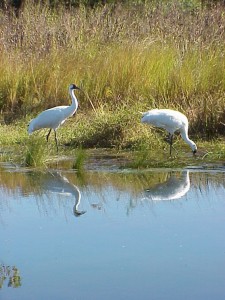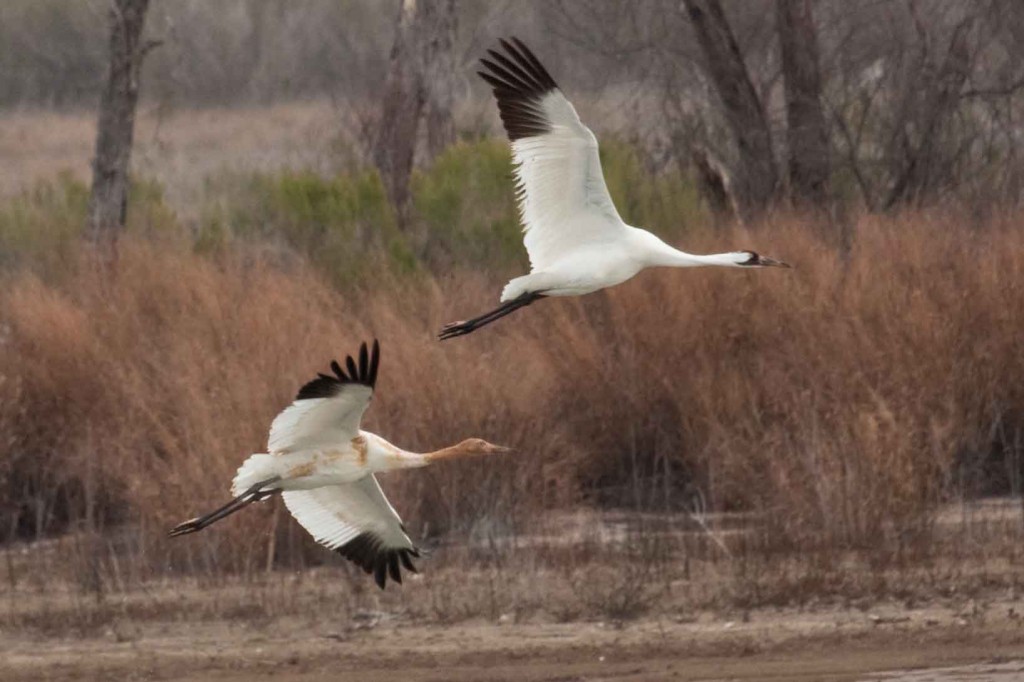Archive for September 29, 2012
Whooping Crane Program Concerns
September 29, 2012by Chester McConnell, Editor
As editor of the Whooping Crane Conservation Association web page, I am concerned about several issues associated with the Aransas/Wood Buffalo whooping crane flock. These issues include the: (1) lack of information available to the public related to the apparent decline in the population of the cranes from 279 cranes in 2010-2011 to 245 cranes in 2011-2012; (2) the proposed new statistical sampling method to monitor the whooping crane population; and (3) the increasing difficulty to obtain information from government agencies that manage the flock.
I recognize that there have been several major changes in management personnel in both the U.S. Fish and Wildlife Service and Canadian Wildlife Service. Replacing long-term, experienced employees in complex programs normally results in some glitches. And then, the unusual weather and related food availability during the past year has seemingly caused migration abnormalities. I try to take these into consideration. Yet, when we cannot get any information on the whooping crane reproduction circumstances on Wood Buffalo habitats, I cannot fathom that. Good golly, the cranes are already beginning their migration south to Aransas National Wildlife Refuge, Texas and we have not heard a word about hatching success and related information during the past spring and summer. Why?
A major factor in the success of any program such as the whooping crane endangered species project is strong public support. Officials involved in the program today would be wise to review the history concerning how the Aransas/Wood Buffalo flock project evolved. In summary it was largely due to strong public pressure and long-term support from early U.S. and Canadian leaders in the Whooping Crane Conservation Association. We want to continue supporting the program but we need information from government project personnel to do so.
I visited the Aransas National Wildlife Refuge this week and discussed some of these issues with a couple of officials. The refuge is being managed well and the new observation tower is a tremendous improvement. They invited me to attend the U.S. Fish and Wildlife Service meeting in Fulton, Texas October 4, 2012 to participate in a briefing on crane survey methodology changes. Hopefully, we will at least get some answers and improved understanding about what is going on during this session. I urge you to attend.
UPDATE: The U.S. Fish and Wildlife Service just released (October 3, 2012) it’s report, Aransas-Wood Buffalo Whooping Crane Abundance Survey (2011-2012)”. We will be studying the report but have included it here so you, our viewers, will have the most current information.
The following news release provides details about the meeting.
News Release: Updates from The Aransas Project SEP 28, 2012
The Aransas Project (TAP) Members Urged to Attend Briefing on Crane Survey Methodology Changes
TAP members are urged to attend a critical public meeting being hosted by the Aransas National Wildlife Refuge to address the changes being made in the survey methods used to count the endangered whooping cranes that winter at the Refuge. Beginning in the winter of 2011-2012, U.S. Fish & Wildlife Service (USFWS) altered its methodology for tracking how many cranes are in the flock and this will be the first public meeting providing any insight or explanation of their methods. TAP members are strongly encouraged to attend to remain informed on this critical issue.
Thursday, October 4, 2012
6 PM to 8 PM
Paws and Taws Convention Center
402 North Fulton Beach Road, Fulton, TX 78358
According to a USFWS news release, the presentation “will investigate and define aerial survey methods used historically and currently to count the Aransas-Wood Buffalo flock of whooping cranes.” Refuge Biologist Brad Strobel will lead the presentation, and there will be a Q&A session following the presentation.
State of the Flock Report: TAP Concerns Persist
In July 2012, TAP released our State of the Flock 2011-2012 report, highlighting the following concerns:
• USFWS Methodology Faulted
Concerns regarding the new statistical sampling method used by USFWS, including reported concerns by former Refuge Biologist and Whooping Crane Recovery Coordinator Tom Stehn;
• Whooping Crane Flock Numbers Plunge during Winter 2011-2012
A stunning decline in the population of the cranes, even under USFWS’ statistical sampling method, from 279 cranes in 2010-2011 to 245 cranes in 2011-2012; and
• Tracking Data Suggests Unprecedented Crane Mortality
Evidence gathered from a smaller population of cranes tracked by GPS that suggests an unprecedented crane mortality of 9.6% in this monitored subgroup of birds that exceeds the previous high mortality rate of 8.5% experienced during the winter of 2008-2009.
USFWS Yet to Deliver Final Report
In their June 14, 2012 report, USFWS indicated they would issue a final “State of the Cranes” report by August 2012 summarizing the significant events that occurred during the 2011-12 whooping crane season. To date, USFWS has not released this annual state of the flock report.
TAP remains concerned about the absence of this report along with the changes in the survey methodology being used by USFWS to monitor the health of the Aransas-Wood Buffalo flock, and invites TAP members to come to the meeting to remain informed on this issue and ask questions of the Refuge staff.
USFWS Appoints New Crane Coordinator, Dr. Wade Harrell
In related news, USFWS recently issued a news release announcing the appointment of Dr. Wade Harrell as the new Whooping Crane Recovery Coordinator. According to the release, Wade will be part of the Region 2 Recovery staff in Albuquerque, but he will be based at Aransas National Wildlife Refuge. TAP welcomes Dr. Harrell in his important new role, and we hope that TAP members will have the opportunity to meet Dr. Harrell at the upcoming meeting.
We hope that you will join us.
Thanks so much for your continued support. Please feel free to forward this on to a friend.
Ron Outen
REGIONAL DIRECTOR, THE ARANSAS PROJECT
Young Whooping Crane In Capture Project Dies
September 3, 2012 |
|
Young whooping cranes, 31 in all, have been banded with transmitters for three summers in their summer Wood Buffalo National Park habitat. (Photo: Courtesy of Parks Canada)
|
A juvenile whooping crane has died, possibly from a self-inflicted wound suffered trying to escape capture in Wood Buffalo National Park. The bird was to be banded as part of a program attaching radio transmitters to juvenile cranes. The carcass has been shipped to the Canadian Cooperative Wildlife Centre in Saskatoon for autopsy.
“We don’t know the cause of death. The crane was injured. It may have happened as part of the capture process,” Stuart McMillan, Wood Buffalo National Park manager of Resource Conservation told The Journal.
Crews land in a helicopter and try to round up the young birds, which naturally run away. McMillan said cranes are known to scratch themselves while running.
The bird was seen to be injured after it was captured for the banding process. A veterinarian is part of the capture crew and the young bird was examined immediately, treated with an antibiotic and released. It returned to its parents and things seemed normal. Some time later, the signal from the transmitter stopped moving. On investigation, the bird was found dead.
“It is certainly disappointing. We didn’t want to have a result like this. We want to find out what happened to prevent it from happening again,” said McMillan.
He said if the cause of death is from the capture process they will study it and make changes to procedures to minimize the risk of it happening again.
The banding exercise, called “telemetry,” is a joint Canada-US project. Thirty one juvenile cranes have been outfitted with transmitters over the last three years without incident.
Migration routes, habitat sought during migration, food sources and threats cranes face are just some of the information the project hopes to gather. The data is still preliminary, and it is too early to draw conclusions.
It is known that whooping cranes often stop in the same places year after year as they come and go annually between Aransas Wildlife Refuge in Texas and Wood Buffalo National Park in the NWT. In some places where they are known to stop each year, people gather to watch for them. It is hoped that public awareness can be raised once more is learned about where and when they stop.
One thing being investigated is the impact of power lines. Dead cranes have been found in the vicinity of power lines but no one knows why. Some speculate lines should be marked along the migration route and that new lines planned in those locations be erected at different sites. One benefit of the radio transmitters is that a dead bird can be found right away.
“When a crane dies it is best to look at an intact carcass to determine the cause of death, not one decomposed or torn apart by scavengers. If banded with a transmitter which stops moving, we can go look for the bird right away,” said McMillan.
This winter, adult birds will also be captured and banded at the Aransas Wildlife Refuge.
Tracking Whooping Cranes – Telemetry Update
September 1, 2012Article courtesy of Crane Trust
The Crane Trust continues to gain momentum in their efforts to contribute to conservation and the preservation of the whooping crane and other migratory birds. The Whooping Crane Conservation Association applauds their work and believes viewers of our web page will appreciate reading one of their recent reports. The following is an excerpt from Crane Trust’s July-August newsletter.
The Crane Trust is one of five research groups involved in a remote-tracking study of whooping cranes in the world’s only self-sustaining flock—the Aransas-Wood Buffalo population, comprised of fewer than 300 cranes. Findings from the study will help the Trust and its partners better understand the ecology and threats to whooping cranes on their wintering grounds, breeding grounds, and their 2,500-mile migration route through the Central Flyway. Twice each year, the Whooping Crane Tracking Partnership publishes an update on its progress and findings. For the two latest reports on progress and findings, click downloads below. Above photo courtesy of Michael Sloat.
2011 Fall Report DOWNLOAD (2011 summer breeding/fall migration)
2012 Spring Report DOWNLOAD (2011-2012 winter season/spring migration)
You can download the two most recent reports at the end of this summary. Of note, the study’s research team has improved its methods of trapping and continues to catch and mark young and adult whooping cranes with GPS transmitters on both breeding and wintering grounds. For each bird, the solar-powered transmitters provide up to 4 signals a day for the life of the device (3-5 years). In the winter of 2011, that amounted to more than 11,000 locations for tracking and analysis. To read the entire article click on following link: http://www.cranetrust.org/newsletter/july-august-2012/tracking-whooping-cranes-in-space-and-time%E2%80%94telemetry-update/



